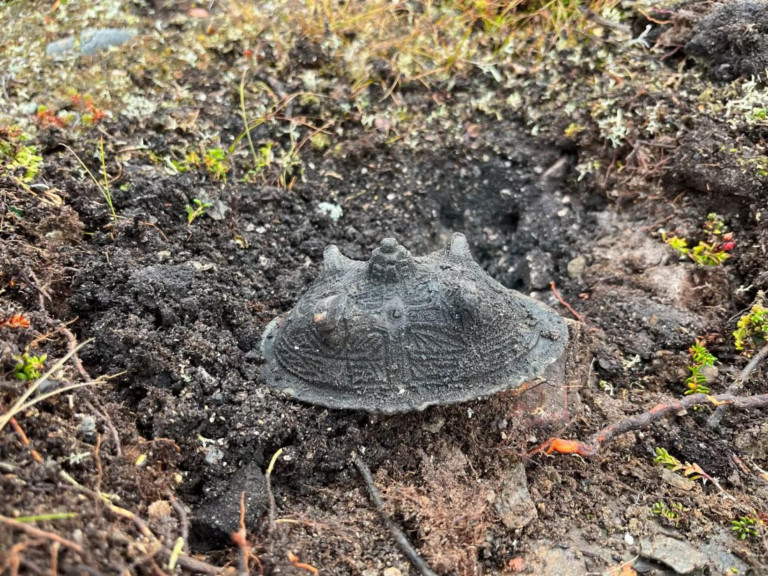In the breathtaking mountains of Jämtland, located in central Sweden, what began as a simple camping trip unexpectedly evolved into a remarkable archaeological revelation. An avid hiker named Eskil Nyström was setting up his tent when he noticed something protruding from the ground. At first, he assumed it might be an ordinary rock or perhaps a leftover fragment from an old mining operation. However, he had unknowingly stumbled upon an ancient artifact that would eventually lead to a groundbreaking discovery about Viking burial traditions.

The object Nyström had found was a brooch—simple in appearance, yet remarkable in age and historical value. He didn’t immediately understand the importance of his find and kept it in his possession for almost a year. Eventually, his curiosity got the best of him, and he brought the brooch to the Jamtli museum in Östersund. There, experts recognized it as a 1200-year-old Viking artifact, sparking interest and prompting an archaeological investigation into the area where it was found.
Archaeologist Anders Hansson from the Jamtli museum visited the location to assess the site. What he discovered would reshape current knowledge about Viking activity in the region. He uncovered signs of a cremation burial—charred remains, fragments of burnt bones, and traces of soot on the soil. Alongside this evidence, a second brooch was discovered, an oval-shaped piece commonly associated with female Viking graves. These findings strongly indicated that the site was a Viking-era cremation burial belonging to a woman.
What makes this discovery particularly groundbreaking is its unique context. Until this point, all previously uncovered Viking graves in the Swedish mountains had been associated with male individuals. This find represents the first known female Viking grave in this geographical setting. It suggests that Viking women were not only part of expeditions into mountainous regions but that they may have played important roles within these journeys.
Hansson, reflecting on the simplicity of the burial site, speculated that the woman may have died while traveling through the mountains. Her companions, unable to continue with her body, may have decided to cremate and bury her on the spot. The grave itself lacks any traditional monument or stone marker, blending almost seamlessly into the natural terrain. It is a flat hill, unremarkable in appearance, but now known to hold significant historical importance.
This finding sheds new light on Viking burial practices during the early Viking Age, a period known for both inhumation and cremation rituals. Cremation, in particular, held deep religious and cultural meaning for the Vikings, believed to release the spirit into the afterlife. The discovery of burnt bones and soot at this site not only confirms the use of cremation in mountainous areas but also suggests that the Vikings adapted their burial rituals based on their circumstances and environment.
Equally compelling is what this tells us about Viking social structures and gender roles. The presence of the brooches, typically worn by women of status, indicates that this woman may have held a prominent role within her community. Viking women were often involved in trade, family leadership, and even voyages—challenging the conventional portrayal of Viking society as overwhelmingly male-dominated. This grave could serve as a powerful symbol of the mobility and agency of Viking women during this period.
The implications of this discovery extend far beyond the single grave. Plans are underway for more extensive excavations in the coming summer. Archaeologists hope to uncover additional artifacts or evidence that might paint a broader picture of Viking activity in the Swedish mountains. Perhaps more graves lie nearby, or remnants of settlements waiting to be unearthed. Every fragment and relic holds the potential to reshape what we thought we knew about Viking life, migration, and death.
This small brooch, found purely by chance during an ordinary camping trip, has now become a symbol of a much larger historical narrative. It has opened the door to a new understanding of Viking presence in regions previously thought to be inhabited only by male warriors or travelers. The very idea that women not only traveled but were buried in these remote mountainous areas challenges long-held beliefs and encourages scholars to revisit other findings with a fresh perspective.
As researchers prepare to return to the site, the excitement within the archaeological community is palpable. Each new clue offers the possibility of rewriting parts of Viking history and bringing forgotten lives back into the spotlight. The discovery has also sparked renewed public interest in archaeology and Viking heritage, reminding us all that even the smallest object can have the power to transform our understanding of the past.
In the end, what began as a simple hiking trip transformed into a discovery with far-reaching implications. From a single brooch emerged a forgotten story—one that challenges historical assumptions, highlights the role of women in Viking society, and offers a rare glimpse into life and death in the Viking Age. As excavation efforts continue and new chapters of this story unfold, the legacy of that humble brooch will endure, connecting the modern world with the rich, complex tapestry of ancient Scandinavian history.





